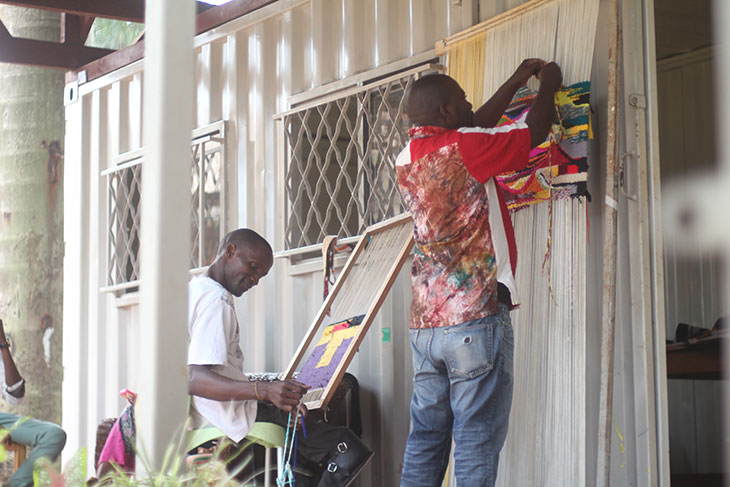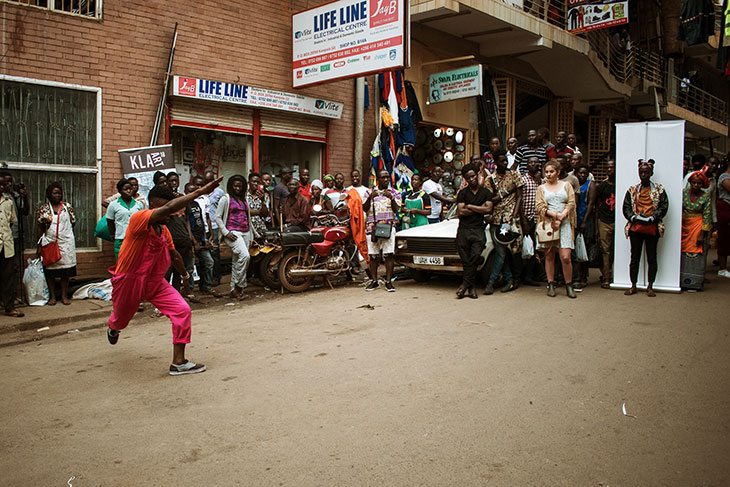Director, 32° East | Ugandan Arts Trust, Kampala
Continuing our series of interviews with individuals selected for the Apollo 40 Under 40 Africa
Recent works by artists-in-residence at 32° East have included Nikissi Serumaga and Martin Kharumwa’s photographic exploration of ageing in Uganda; Trevor Aloka’s hyperrealist paintings exploring stereotypes of masculinity among Langi communities in the north of the country; and the murals, installations and collages of, respectively, Willy Karekezi, Bathsheba Okwenje and Gael Maski under your ‘Politics of Return’ social residency programme. You’ve covered a huge range of mediums and genres over the years – how instrumental has 32° East been, since its founding in 2011, in establishing this kind of multidisciplinary practice in Uganda?
32° was founded with a desire to really understand the context of what was already here – to create something that could be complementary to what already exists. While there were many artists in Uganda during the 1960s and ’70s who became known predominantly for their work in one genre – I think above all of Joseph Ntensibe, one of our masters in painting – over the years interdisciplinary artists have become much more prominent; 32° didn’t establish these kinds of practice, but we have done a lot of work to highlight them and share them with broader audiences.
The founders of 32° were two British women [Rocca Holly-Nambi and Nicola Elphinstone], who had both recently moved to Uganda. There are plenty of people who, in similar circumstances, have just decided to start an organisation without doing their due diligence, but the founders began by getting to know the artists who have been working here, who explained that what they really needed was a space where they can do proper research, as well as having opportunities for exchange, with other artists working in the same space. Previously a lot of these artists had been working in isolation. We were able to create an environment where someone who works with clay could all of a sudden find themselves in residence with someone who works with fabric. They might not necessarily collaborate directly – but the kinds of conversations that they’re able to have can still push their practice forwards in interesting ways. So I think that the role of 32° has really been as a sort of community gatherer – a home where people can connect across different disciplines and generations.

Courtesy 32° East | Ugandan Arts Trust
Your own academic background is in anthropology and sociology. Does the social impact of art play a role in your work at 32°?
One of the key things in this respect is our festival, KLA Art, which had already had two editions by the time I became director [in 2016]. It began with 12 local organisations coming together to host it; 32 took it on for the second edition, because they saw how much value it had for the city.
There aren’t many other avenues for people in Kampala to get to see art – you don’t generally go to galleries or museums when growing up. There aren’t many murals or statues in the city, and a lot of the monuments that do exist are quite political. Public space is really contested, something that we’re very much experiencing right now [with recent unrest]. Freedom of assembly can be viewed as a threat by the government, and a lot of private companies are reticent to having anything on their property that isn’t branding. I think that creating work in public spaces, creating a channel for people to communicate in a different way, is really interesting in terms of its social impact.

View of Hellen Nabukenya’s Muno Mu Kabi (A Friend in Need) (2018) during KLA ART in Kampala in 2018. Photo: Jim Joel Nyakaana; courtesy 32° East | Ugandan Arts Trust
How has 32° succeeded in changing local perceptions of the visual arts?
These things are hard to measure – we don’t go around with written forms for feedback! But there are little stories I can tell. During the 2018 edition of KLA Art Festival, there was one large-scale work by Hellen Nabukenya [Muno Mu Kabi (A Friend in Need); 2018] installed along the side of a building right outside the old taxi park, at the end of Kiyembe Lane – a location she chose because it has historically been a place where the tailors of the city would work. Back in the day, before it became so busy, tailors would sit under a mango tree and gossip – groups of women weaving together, sharing issues with their relationships, news of their children, etc. Hellen works with strips of discarded fabric, so she’s very familiar with Kiyembe Lane; she collaborates with these groups of women to put together her large-scale tapestries. At the festival, we conducted tours with the tailors; we got to hear them talk about working with Hellen. They’d often point out how nice it was to actually to get to see her work – because art doesn’t often get shown in those particular areas before it’s shipped off to a gallery.
Another great moment was a performance with two dancers, by Jared Onyango – something of a guerrilla performance, because we didn’t have all the right permissions to do it. The dancers took over the street for five minutes – we had to stop the traffic, and we could see a lot of people just looking around wondering ‘what is happening?’, because it’s so rare to see the normal flow of the city being disrupted like that. We saw them laughing, asking each other questions, and then gradually starting to explain what was going on to one another.

Jared Onyango’s performance at KLA ART in Kampala in 2018. Photo: Muhammad Ali Kanch; courtesy 32° East | Ugandan Arts Trust
Does 32° look to collaborate with other contemporary art centres across Africa?
Collaboration is just so necessary – when there aren’t always that many financial resources available, you have to use the other kinds of resources you have, which are above all your networks: the knowledge and experience of people who have been doing it for longer than you have. When Bisi Silva set up the Àsìkò art school [in 2010 in Lagos] she created many opportunities for artists and curators to participate in that programme; those experiences were completely transformative for those who took part. For us it’s always been important to look at the impact of projects like this, or like Raw Material [in Dakar], Waza Art Centre in Lubumbashi; Doula’Art in Cameroon… When 32° started, I know the founders talked a lot to the Kuona Trust in Nairobi; we had exchanges with Netsa Art Village, in Addis Ababa, which unfortunately no longer exists. We’ve been fortunate to have been part of a lot of different networks – Arts Collaboratory, Triangle Network, the Prince Claus Fund Network Partnership.
Your major news this year is that you’ve secured the site for a new permanent home for the Trust – the first purpose-built visual art centre in Kampala, with construction due to begin in March 2021. What kind of impact do you think this will have on art in Uganda?
Hopefully a really massive one! There are so many things that are exciting about it but the main thing is the sense of permanence. It’s our plot of land, it will be our building – and we’ve achieved it without a high level of financial investment from the government.
The site is gorgeous – it will be a beautiful building made with rammed earth. It’s a statement of sustainability – both in environmental terms, but also in terms of how an organisation like ours can be run. We hope that we’ll be able to open a cafe, that we’ll be able to rent out some of the studios, so that we’ll bring in some of our own income and not be so dependent on donor funding. We’re all going into a time of great precarity – we’ve seen how many arts and culture organisations have struggled to survive this year – so being able to say we’ll have this stability, this structure for artists, is huge. For me, it’s an opportunity to remake the world in this one small way – to show that art does have value and is worth investing in. It proves that such things can be possible in Uganda.
For more information and to donate to the fundraising campaign for the new centre in Kampala, visit 32° East | Ugandan Arts Trust’s website.








